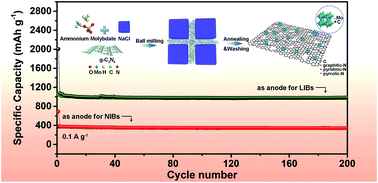Investigating the electroactivity of nitrogen species in MoC nanoparticles/N-doped carbon nanosheets for high-performance Na/Li-ion batteries†
Abstract
Various MoC/nitrogen (N)-doped carbon nanosheet hybrid materials (MoC@NCs) have been synthesized, and the effects of various N dopants [graphitic N (G6-N), pyrrolic N (P5-N), pyridinic N (P6-N), and Mo–N] on the electrochemical properties were systematically investigated. With increasing N-doping of MoC@NCs, the electronic conductivity increases. The formation of Mo–N bonds improves the electrochemical stability of MoC@NCs by pinning MoC nanoparticles (NPs) on carbon nanosheets, while the defective species (P5–N and P6–N) are of benefit for ion storage. Thus, MoC@NC-1.0 displays the best cycling stability and rate capability for both sodium-ion batteries (SIBs) (98% capacity retention after 1000 cycles at 1.0 A g−1) and lithium-ion batteries (LIBs) (762 mA h g−1 at 1.0 A g−1). This work not only presents an in-depth understanding of how various N dopants can enhance the electrochemical properties of MoC@NC electrodes but also offers new avenues to develop novel electrode materials for alkaline-ion batteries.



 Please wait while we load your content...
Please wait while we load your content...